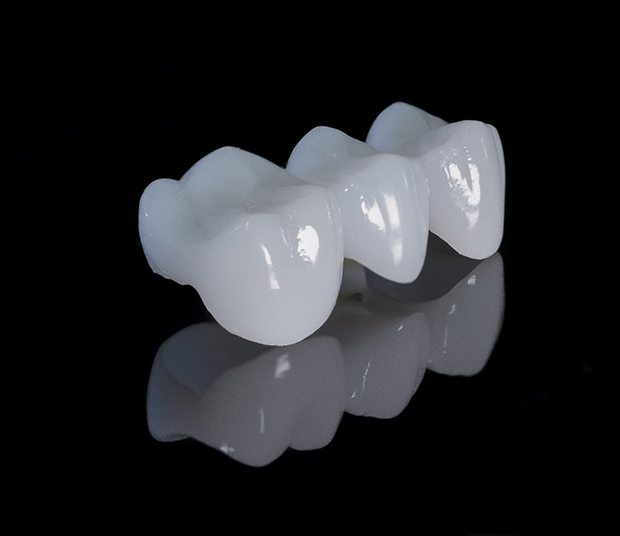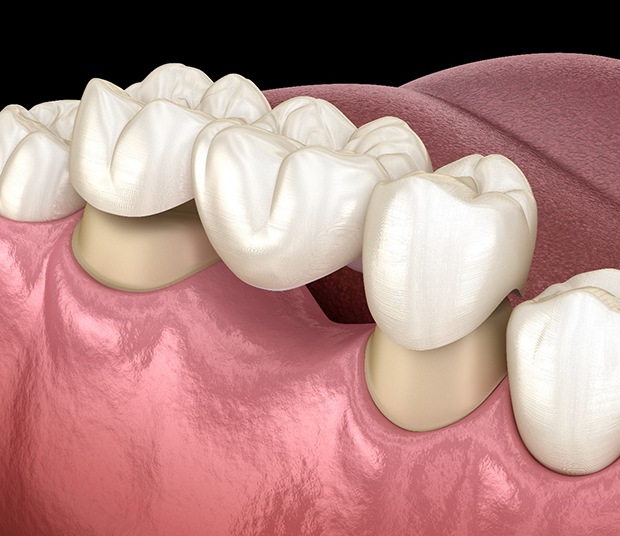Dental Bridges – Dallas, TX
Helping Our Patients Re-Complete Their Smiles
Even a single missing tooth can lead to problems in your everyday life. It’s best to have the gap filled as soon as you can, and oftentimes Dr. Henry will suggest using a dental bridge to do so. Whether you have lost one tooth or multiple teeth in a row, a dental bridge can help you once again enjoy a complete smile. Reach out to us if you would like more information about dental bridges and the steps involved in having one placed.
Why Choose Skillman Family Dentistry of Dallas for Dental Bridges?
- Fully Personalized Replacement Teeth
- Knowledgeable, Experienced Dentist
- Saturday Appointments Available
What is a Dental Bridge?

A dental bridge is a form of tooth replacement that is generally used when there is a single gap in the smile that needs to be filled. Each bridge includes a number of free-standing replacement teeth known as pontics, which are suspended between a pair of dental crowns. Said crowns are used to keep the entire prosthesis anchored in place. Just like dental crowns, dental bridges can be made out of aesthetically pleasing materials that help them look like natural teeth.
Types of Dental Bridges

Choosing the right form of tooth replacement could make all the difference for your quality of life, so it’s important to consider your options carefully. After evaluating your mouth and the state of your oral health, we can help you figure out which kind of dental bridge you should get.
Traditional Dental Bridge
If the teeth adjacent to the gap in your smile are still in good condition, they can potentially be used to support a traditional dental bridge. To create room for the bridge, we’ll need to file a bit of enamel off of the teeth in question. A traditional bridge can be a good option for patients who have lost just one tooth, but it can also be a viable solution for two or more consecutive missing teeth.
Implant Bridge
Sometimes dental bridges can be attached to dental implants instead of your natural teeth. This option can be considered if three or more teeth in a row need to be replaced. Bear in mind that the process of having dental implants placed can take months since the posts need time to form a bond with the jawbone.
The Benefits of Getting a Dental Bridge

- The bridge will completely fill in the space left by the missing teeth. As a result, the remaining teeth won’t drift out of alignment.
- You will be able to enjoy an enhanced sense of self-esteem once the gap in your smile has been filled with natural-looking replacement teeth.
- Dental bridges are very easy to take care of since they can be brushed as if they were natural teeth.
- A dental bridge can potentially last as long as 15 years provided that you give it proper maintenance.
Dental Bridges FAQs
Are Dental Bridges Intended to be Removed?
Many patients have heard partial dentures referred to as ‘removable bridges’, leading them to wonder whether their prosthetic is intended to be easily taken out and reinserted. However, these two restorations are different treatments and should not be confused.
Dental bridges are cemented over abutment teeth or implants in your mouth and are intended to remain in place until they require repair or replacement. Meanwhile, partial dentures usually clasp in place with metallic clips and should be taken out twice daily to be washed thoroughly.
What Are Dental Bridges Made From?
Historically, replacement teeth like dental bridges were made from silver amalgam mixtures that, though durable, stuck out like a sore thumb. Thanks to more recent advancements in dental materials and technology, today, Dr. Henry can provide a lifelike restoration to replace one or several consecutively missing teeth.
Instead of being composed of dark metal that glints in the sunlight or leaves your grin looking gray, our team uses resilient tooth-colored resin or ceramic that can be customized to match your natural hue for seamless results.
Is Getting a Dental Bridge Painful?
Many people near Dallas experience anxiety around dental visits, especially if they’re concerned that their procedure will be long and agonizing. Fortunately, getting a dental bridge doesn’t usually hurt! For starters, Dr. Henry will apply a local anesthetic before starting your procedure to help you feel comfortable the entire time. He also offers nitrous oxide (laughing gas) sedation if you’re overly worried or struggle to sit still for longer periods.
Then, unless you’re getting dental implants, he must prepare the abutment teeth by removing a thin enamel layer. This protective coating doesn’t regenerate and can leave your pearly whites feeling somewhat sensitive until they adjust to the change. Taking Tylenol or ibuprofen is usually safe to address any associated aches or inflammation until they subside on their own.
If you experience prolonged or severe discomfort, call us right away so we can ensure your prosthetic fits correctly.
How Long Do Dental Bridges Usually Last?
These restorations typically last anywhere from 5 to 15 years, though they’ve been known to stick around longer if they’re cared for properly. For instance, brushing and flossing twice daily removes plaque and bacteria that contribute to common oral issues, such as cavities or gum disease. Although your bridge can’t decay, the underlying teeth can, which can cause it to fail. You can also extend its lifespan by avoiding overly hard or sticky foods that can damage or dislodge it.
Also, bridges placed over molars in the back of your mouth sustain additional pressure from frequently chewing, which can wear them down faster than bridges replacing front teeth.
